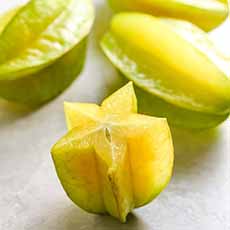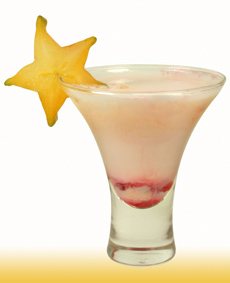TIP OF THE DAY: Starfruit (Carambola)
|
Don’t pass up the opportunity to decorate your food with starfruit this season. These “edible stars” can be used just about everywhere:
Starfruit or carambola (star fruit is an alternate spelling) is the fruit of a species of tree (Averrhoa carambola) native to southeast Asia. Starfruit was brought back home by sailors and traders in the late 1700s, and became popular with wealthy Europeans. It was brought to Hawaii by Chinese traders in the late 1800s. Yet, it was introduced to mainland America—Florida—only about 75 years ago. Today, Florida is the largest producer of American-consumed starfruit. The tree is also cultivated throughout the subtropical belt, including Florida, Hawaii and Puerto Rico. These are the fruits that are sold in the U.S., as a result of import restrictions due to potential pests that often accompany the fruit. Named for the five-pointed star shaped slices it yields when cut horizontally, the pale yellow, juicy flesh with a distinctly tropical orange-pineapple flavor contains a few small, flat seeds. Not only is starfruit attractive; it’s healthful, too. Starfruit is rich in vitamin C antioxidants and low in sugar and acid (though it should not be consumed by people with kidney problems). The fruit is nicely crunchy like an apple. The thin, edible skin, is lime green on the tree and ripens to a bright yellow, shiny/waxy sheen. |
|
|
|
Starfruit has so much more flavor and sweetness when it is allowed to ripen on the tree. Much of what is available outside Florida, Hawaii and Puerto Rico has been picked green. It just isn’t the same. So when you’re there during the season, seek them out. There are two main types of starfruit—sweet and tart—so you may have to ask the produce manager to clarify which type you’re looking at.
|
||




